There's Nothing More Tedious Than Heavy Traffic And Snow: In this early 1950s Philadelphia street scene, cars and trucks are lined up as snowflakes fall at 3:45 pm on a workday.
At left, a dark-colored Philadelphia Bulletin truck is visible, with a two-tone Hellmann's Mayonnaise truck behind it. A Mobil gas station can be seen with a printing plant next door. Atop the plant is a billboard advertising the Philadelphia Inquirer newspaper. (posted 12/12/21, permalink)
Down At The Station: A late 1940s photo - posted at The Old Motor - was taken on a cold winter day at the Pennsylvania Railroad's Villanova station.
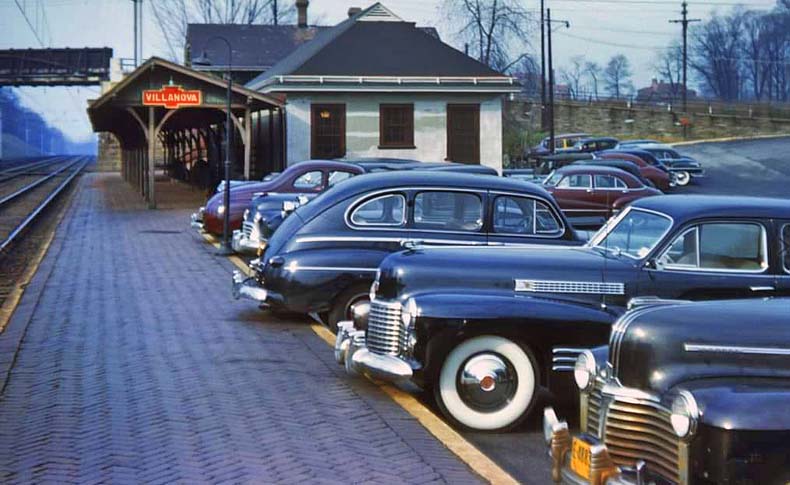
The photo looks westbound toward Paoli; the station is northwest of the main Villanova University campus. The station building was originally built in 1890 by the Pennsylvania Railroad and is within the campus of Villanova University. The rail service is part of the Pennsy's Main Line operation and is four-tracks wide. A second station (not shown) is on the other side of the tracks and is accessible via a staircase, underground tunnel and second staircase. The underground passage is still in use today.
The cars in the parking lot probably belong to commuters who take the Paoli local to downtown Philadelphia. They would have ridden in MP54 electrically powered, Multiple Unit interurban cars with overhead pantographs and distinctive circular front windows (porthole windows - railroad buffs refer to the them as 'owl eyes') powered by overhead wires. The Main Line had been electrified since September 1915. The cars were painted Tuscan Red with gold Pennsylvania lettering in those days.
From right to left the cars include a black 1941 Pontiac with a rusty grille, a shiny 1941 Cadillac 62 navy blue touring sedan with nice wide whitewall tires, a 1946 Ford Super Deluxe black sedan, a late 1920s-early 1930s coupe, possibly a Packard, a blue 1947 Oldsmobile and a maroon 1941 Ford business coupe. (posted 12/8/21, permalink)
Childhood Mosquito Memories: In Philadelphia, trucks came around fairly often to spray big clouds of DDT (Dichlorodiphenyltrichloroethane) to control the mosquito population.
In Brigantine, NJ, where my parents had a summer home, a Jeep fitted with large tanks came by every evening spraying DDT. Brigantine also used a red biplane for aerial spraying in swampy areas not accessible by road.
DDT did a helluva good job but was banned in the United States in 1972 by the EPA. DDT is classified as a class 2 insecticide, meaning it is moderately toxic. The insecticide has shown to cause chronic effects on the nervous system, liver, kidneys, and immune system of wildlife. It has also been found that humans, who were occupationally exposed to DDT, suffered chromosomal damage. (posted 10/19/21, permalink)
Fairly Swift Justice: Reading about the parole of Sirhan Sirhan, who killed Robert F. Kennedy in 1968, I was reminded that we now live in an age where murderers on death row avoid the death penalty for decades. Some actually die of old age before their execution is carried out. It didn't used to be this way.
On December 28, 1959, 16 year-old Maryann Mitchell from the Manayunk neighborhood of Philadelphia went missing. Three days later, her body was found in the Montgomery County suburb of Lafayette Hill, PA.
Maryann, a junior at Cecilian Academy Catholic School for Girls in West Mount Airy (a private school which closed in 2003), stopped at three places on December 28th. She visited her great aunt in Manayunk; she saw a movie at the Roxy Theater with three friends and she had hamburgers at Koller’s Kitchen with two of her friends. Around 10:15 pm, Mitchell walked to the corner of Henry Avenue and Walnut Lane. She stood in the rain, under a red and white umbrella, and waited for the Route A bus to take her toward her Manayunk home at 195 Dupont Street. She was an only child, and had always obeyed her 10:30 evening curfew.
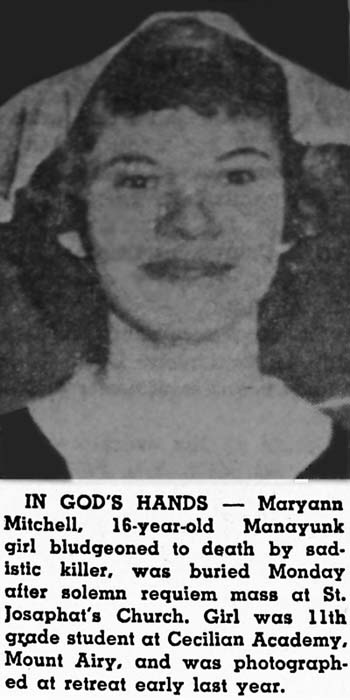
It is believed that one Elmo Smith forced her into a stolen vehicle he was driving and then raped her and bludgeoned her to death. He stripped off her panties and wrote TB101 across her abdomen along with some lines which some believed were symbols of St. Elmo's Fire (a weather phenomenon in which luminous plasma is created by a corona discharge from a rod-like object such as a mast, or spire). Some news reports said the markings were done with red lipstick; others reported that they were carved with a knife. In any case it was a horrific murder. My friends and I followed the story - Maryann was the same age as us.
Poor Maryann she never got to grow up, get married, have kids and grandkids. She would be 78 now. It is said that her parents never got over her brutal murder and went to their graves still in mourning. So sad.
Elmo Smith was a 39-year-old handyman who lived with his parents not far from where the Maryann's undergarments were found during an intensive search. Traces of the former Girl Scout's clothing and belongings were found scattered across 10 square miles between Roxborough and Whitemarsh. Smith was on parole for sexually assaulting at least six women in the late 1940s, which put him on detectives' radar. Shortly after he was taken into custody, police received evidence connecting Smith to a stolen, blood-stained vehicle.
After his photo appeared on television, three 12-year-old Phoenixville girls came forward. They recognized him as the stranger who had attempted to abduct them on December 27th - the day before Mitchell's abduction – as they walked home from a movie. After the girls picked Smith out of a lineup on January 7th, he confessed to the murder.
On September 1, 1960, a jury of nine men and three women took less than two hours to convict Smith of first-degree murder. The next day, after deliberating for less than an hour, the same jury condemned Smith to death.
Smith was executed at 9:01 pm on April 2, 1962. According to a witness, it took less than one minute to fry him good - faster than grilling a Philly cheesesteak. Smith was the last person in Pennsylvania to be executed using the electric chair.
Justice was meted out pretty quickly in those days. And Elmo Smith didn't get a "special final meal of his choice" before execution - such things were unheard-of in 1960. (posted 10/1/21, permalink)
Frankford Library: Located near the Margaret-Orthodox Station of the Frankford EL, the Frankford Branch serves the communities of Frankford, Northwood, Bridesburg, and part of Juniata Park. When I lived in Frankford, this was my go-to place for doing research for term papers.
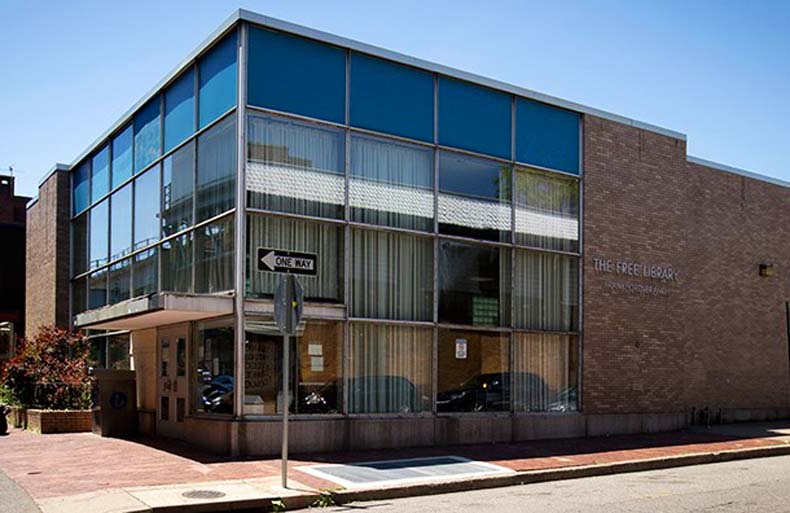
The Frankford Library dates back to 1823. In 1900, the library became part of the Philadelphia Free Library. In 1906, a new Carnegie-funded library was opened at Frankford Avenue and Overington Street site of the present location. In 1959, the neo-classic building was replaced with a modern structure of steel and glass at the same location.
Sixty-two years later, the "new" building still stands; it is a timeless design. (posted 9/21/21, permalink)
Fairmount Park Auto Races: The Old Motor has posted photos from the 1911 Fairmount Park race in Philadelphia, PA. I never knew such car races existed.
Fairmount Park, Philadelphia's first park, is the largest municipal park in Philadelphia, Pennsylvania and the historic name for a group of parks located throughout the city. Fairmount Park consists of two park sections named East Park and West Park, divided by the Schuylkill River, with the two sections together totaling 2,052 acres. The park was the site of the 1876 Centennial Exposition and the first zoo in the United States which is still located within the park's boundaries.
|
|
This is a scene of wealthy motorists' automobiles lined up on the side of 1911 Fairmount Park racecourse in Philadelphia, PA, photographed by Spooner & Wells. These racing enthusiasts usually paid a premium price to see and be seen and have an upfront view of the racing action. Note the police line to keep spectators off of the racecourse. The first three cars in the line on the left are a Packard Model 18, a Winton model 48, and a White touring car.
|
Beginning in 1908, Fairmount Park hosted one of the great road course races of the early 20th Century. The Quaker City Motor Club held annual races run on an eight-mile course in Philadelphia's West Fairmount Park. They drew half a million spectators the first year.
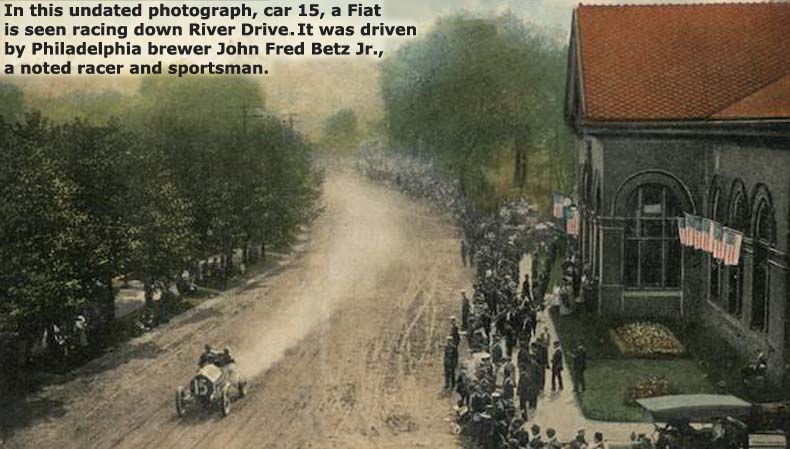
The original rules were that the car must match catalog configuration except for incidentals like mud guards or running boards. Races were 25 laps or 200 miles. There were never any serious injuries and not a single death but after four years the event was banned by the Fairmount Park Commission, after concluding the races encouraged recklessness among automobile drivers. (posted 9/9/21, permalink)
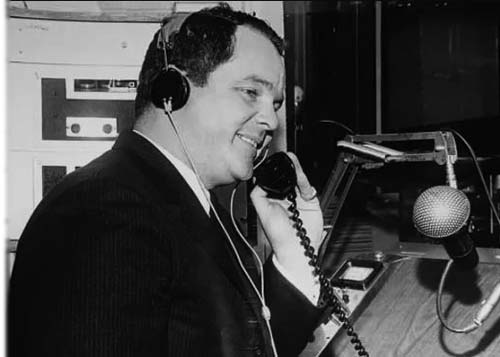 Philadelphia Radio Legend: Bill Wright, Sr. has died at age 92 of senile degeneration of the brain. He passed away August 8, 2021. In the late 1950s and early 1960s, I listened to his radio show on WIBG while commuting to high school and college.
Philadelphia Radio Legend: Bill Wright, Sr. has died at age 92 of senile degeneration of the brain. He passed away August 8, 2021. In the late 1950s and early 1960s, I listened to his radio show on WIBG while commuting to high school and college.
Growing up in Birmingham, Alabama, a childhood illness kept Bill bedridden, listening to the radio. That prompted an interest in radio which led to a lifetime career.
He contracted osteomyelitis, an inflammation of the bones, in his legs when he was 10, and spent the next five years recovering. Surgeries left one of his legs a few inches shorter than the other, and Bill used a wheelchair, crutches, a prosthetic boot, or cane for the rest of his life. His mother gave him a bedside radio during his convalescence and he listened to it constantly. By 1943 he was on the radio as part of a youth choir in his hometown of Birmingham, Alabama. He joined WSGN in 1950 and spent six years at the Birmingham outlet.
Wright's biggest break came in 1957 when he joined the staff at WIBG in Philadelphia. 'The Rebel Wright' established his legend at Wibbage Radio 99 doing the morning show for 11 years as part of a legendary lineup that included Tom Donahue, Hi Lit and Joe Niagara. At one time, it was estimated half of Philadelphia listened to Wright's folksy morning drive show. He associated with such stars as Dick Clark, Rosemary Clooney, Elvis Presley, Chubby Checker, Dinah Shore, and countless others. He greeted the Beatles in Philadelphia during their American debut in 1964.
Wright left WIBG in 1968 and established broadcasting schools in Providence, Rhode Island and Philadelphia, while also doing public relations work. But you can't keep a radio guy away from the microphone forever - in 1986 he joined standards-formatted WPEN in a part-time role, rejoining other WIBG alumni including Joe Niagara.
Wright was inducted into the Broadcast Pioneers of Philadelphia Hall of Fame in 2005. He is survived by his wife, two sons, two daughters, 11 grandchildren; six great-grandchildren; and other relatives. His first wife and his son, Bill Wright, Jr. predeceased him. His life will be celebrated with a funeral Mass at St. Monica Church in Berwyn, PA. Private interment will be in Birmingham, Alabama. Requiescat in Pace, Bill. (posted 9/1/21, permalink)
Old Paint:
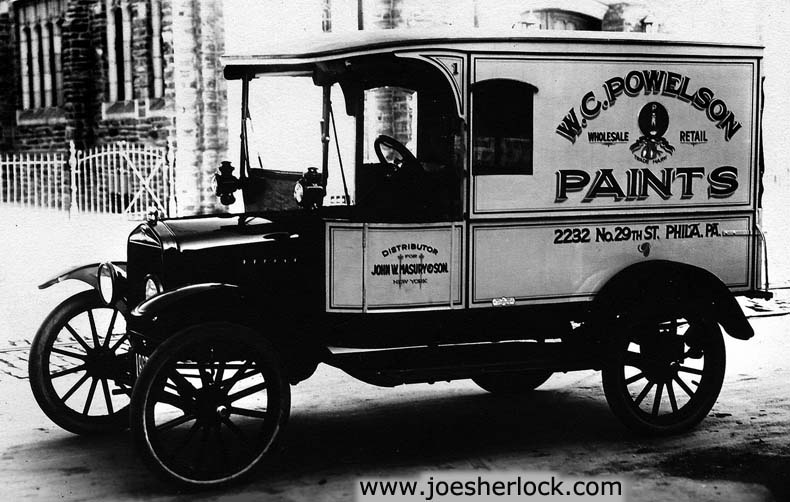
This 1920 Ford Model T is owned by W.C. Powelson, a wholesaler and retailer of paints, located at 2232 North 29th Street in North Philadelphia. From the 1909 edition American Paint and Oil Dealer directory: "Wallace C. Powelson, a paint dealer, does some clever advertising. He uses a trademark - a picture of a painter with an uplifted brush and a can of paint - on a sign on which are the words 'The sign of the paint man'. He also has one of the best-stocked paint stores in Camden, NJ."
W.C. Powelson was a distributor for John W. Masury and Son in New York.
At the age of 22, John W. Masury started working as a clerk in a paint store in Brooklyn, New York in the 1840s. A skilled inventor and businessman, he built a thriving paint business with several partners. In 1870, he became sole owner of the business, which he operated under his own name, and in 1875 he changed the company name to John W. Masury & Son. Masury's many innovations included the patented thin metal lid which could be easily removed from the paint can.
The Masury family had a four-story brownstone at 622 Fifth Avenue, just opposite St. Patrick's Cathedral. The son was an avid yachtsman and member of the New York Yacht Club.
In the 1940s, the Masury manufacturing operations were moved from Brooklyn to Baltimore, Maryland. In 1979, the Valspar Paint Corporation purchased the John W. Masury Paint Company, and the Masury brand was discontinued. (posted 8/26/21, permalink)
Early Moving Van: In the days before central air-conditioning and wall-to-wall carpet, it was not uncommon for people to have their rugs removed cleaned and stored during the summer season. Early woven rugs often curled with heat and humidity, presenting a tripping hazard. Oxford Storage Co. a Philadelphia firm, offered moving and storage as well as rug cleaning. The firm had a main office at the corner of SE corner of 19th and Columbia Avenue, near Fishtown with a branch not far away at 1919 Oxford St., near Temple University.
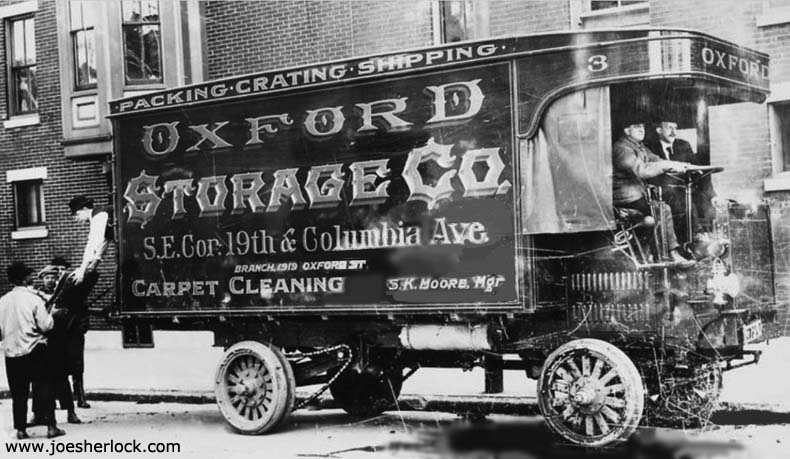
The van is a GMC Model H Reliance, 3.5 ton truck, probably a 1913 model, made in Owosso, MI.
Reliance Motor Company started business in 1902 in Detroit. In December, a 1907 Reliance 3-ton truck was driven from Detroit to Chicago - 304 miles over frozen roads - in less than 4 days. That truck was then displayed at the Chicago Auto Show. William C. Durant founded the General Motors Company on September 16, 1908 and incorporated it in New Jersey. Later that year, Durant bought controlling interest in Reliance and reorganized it as the Reliance Motor Truck Company, a subsidiary of General Motors Co.
In 1913, Reliance gasoline trucks became GMC model series H (3 1⁄2-ton) and K (5-ton). (posted 8/16/21, permalink)
Dullsville: In the 1950s, life in Philadelphia was so dull that people stood around watching the streets get swept.
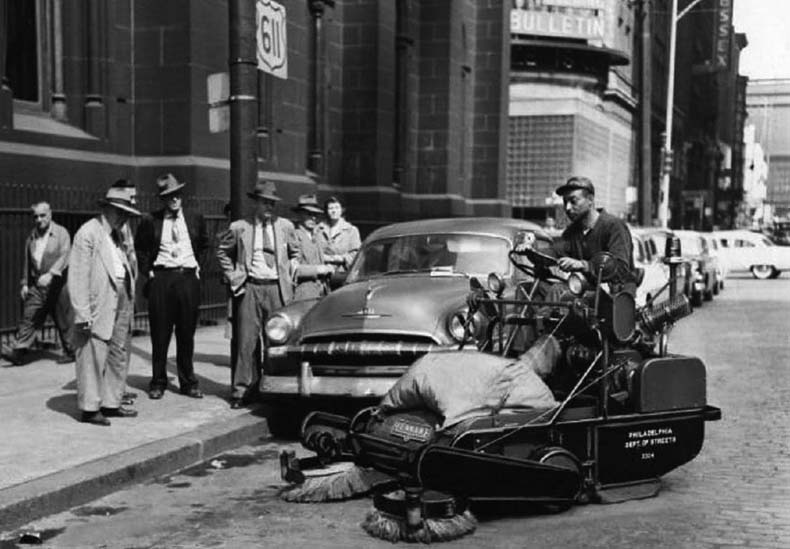
Route 611 in Philadelphia is also Broad Street, a major urban north-south boulevard. The dark-colored '53 Plymouth behind the sweeper has a parking ticket on the windshield. (posted 8/6/21, permalink)
Electric Bus Scam: More than two dozen electric Proterra buses first unveiled by the city of Philadelphia in 2016 are already out of operation. The entire fleet of Proterra buses was removed from the roads by SEPTA, the city's transit authority, in February 2020 due to both structural and logistical problems - the weight of the powerful battery was cracking the vehicles' chassis, and the battery life was insufficient for the city's 'easy' bus routes.
Philadelphia had placed the Proterra buses in areas where it thought they could succeed but quickly learned ... (more >>>)
Bumper Cars: This late-1960s Auto-Skooter brochure was from Lusse Brothers of Philadelphia, PA.
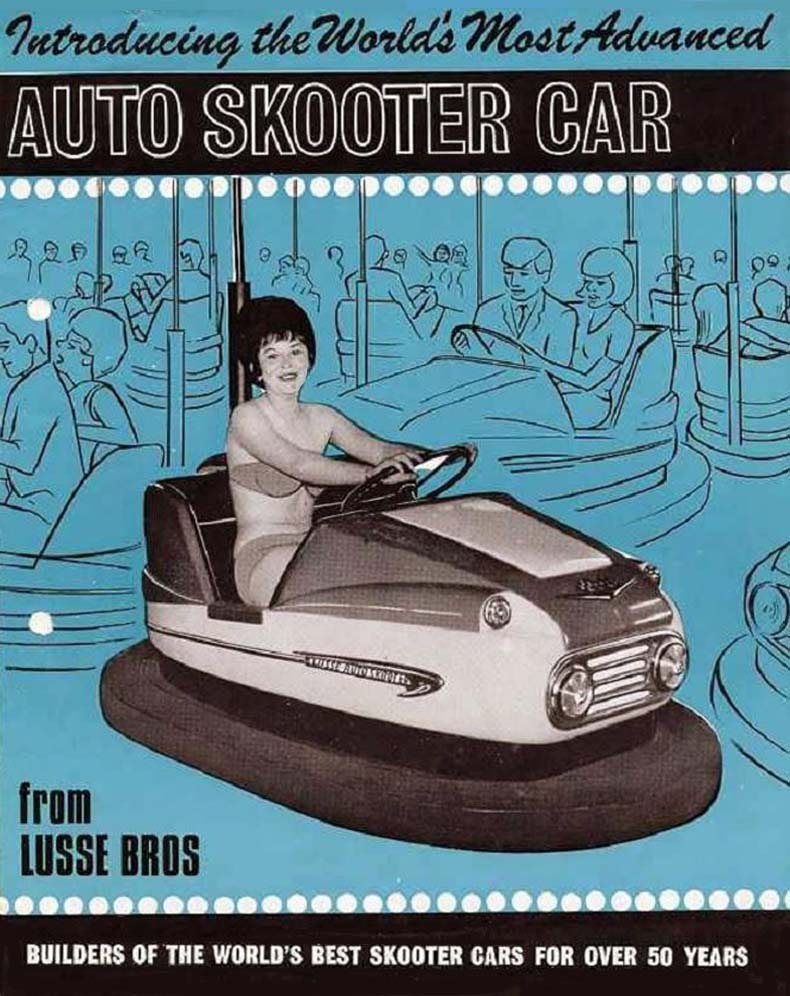
Cousins Joe and Ray Lusse ran a machine shop supplying roller coaster parts to Philadelphia Toboggan Co. In 1922, they began designing a bumper car to compete with Dodgem Corporation. Eventually, they developed a more controllable bumper car, brought it to market and prospered. I've posted more information about Lusse Brothers here. (posted 7/26/21, permalink)
Life Is A Lark: I've been reading 'Willow Grove Park', a book which is primarily a bound collection of captioned photographs. It brought back a lot of fond memories of this long-defunct Philadelphia area amusement park and its slogan, "Life is a lark ... at Willow Grove Park."
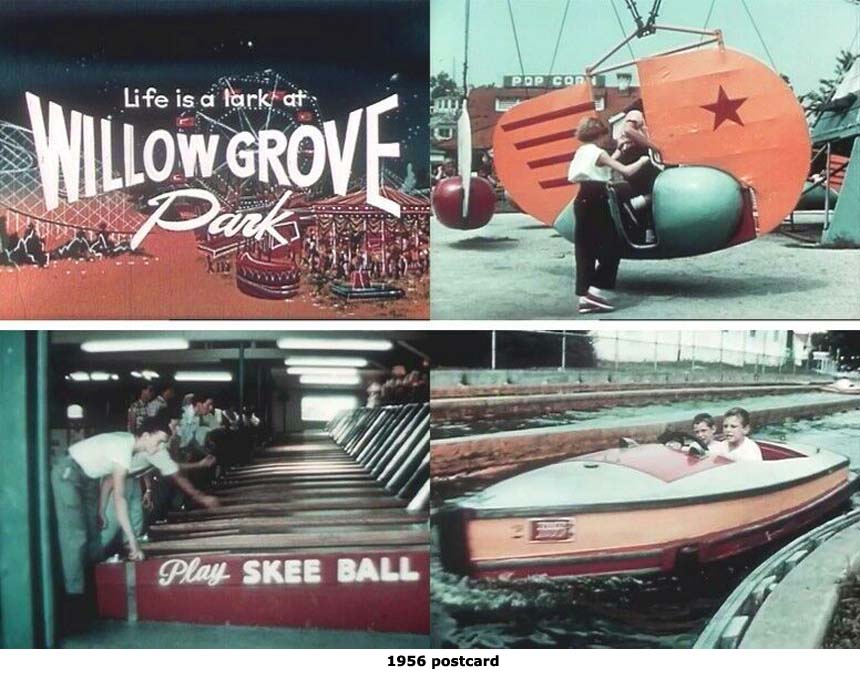
The book covers the period from the amusement park's 1896 opening until its final days in the mid 1970s. (A large shopping mall is now on the site. Like the U.S. needed another one.)
It was interesting to see how the park and the rides changed over the years. In order to keep people coming back, old rides would be discarded and new rides would replace them. In its early days, one of the biggest attractions ... (more >>>)
Old-Time Washer: If you've ever wondered where the term 'automatic washer' came from, take a look at its predecessor from 1941. This unit had a manual shift lever for various wash cycles. When the wash was finished, the clothes were run through the attached wringer to squeeze out excess water. Then they were ready to be hung out to dry. These types of washers were still made and sold in the early 1960s, although most of the world had moved on to automatic washers, with automatic water-fill, agitate and spin cycles.
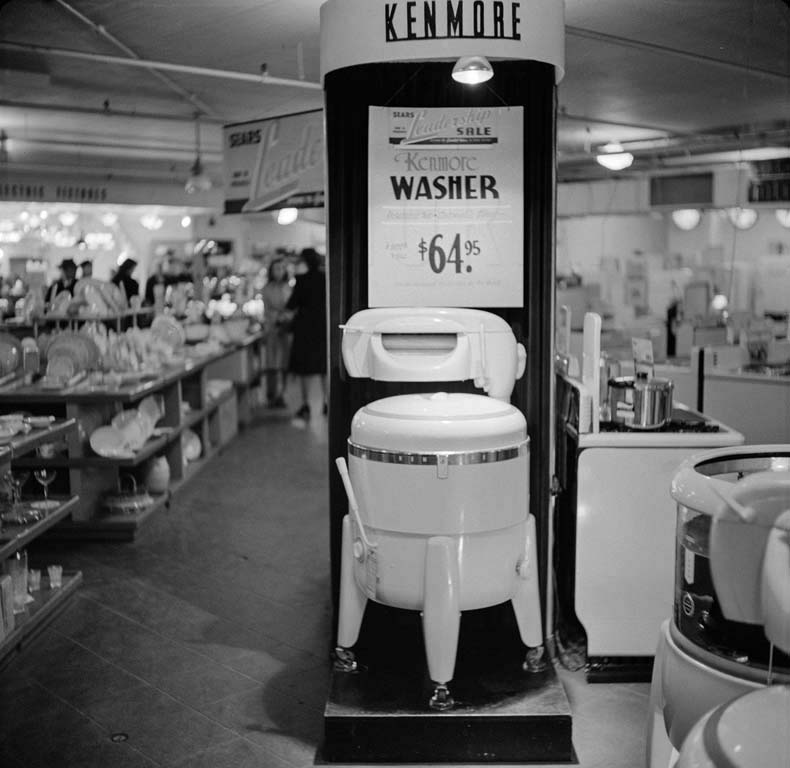
In the 1930s and '40s, these washers could also be purchased with a small gasoline engine in place of the electric motor for homes which lacked electricity.
In Northeast Philadelphia, there was a giant Sears & Roebuck nine-story complex, over 25 million square feet, which included a 14-story clock tower - an icon to Philadelphians driving past on Roosevelt Boulevard. Built in 1920, this was the nine-story regional Sears office and shipping department for customers in the mid-Atlantic states. The neo-Gothic brick building was designed by George C. Nimmons, a Chicago-area architect who had worked for Sears, Roebuck & Co. previously, even designing the company president's home.
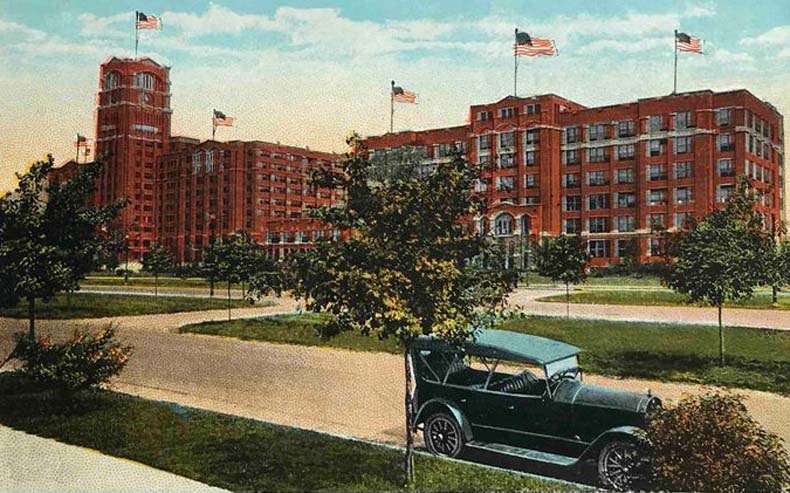
Even with the success of the Roosevelt Boulevard building, the overall decline of mail-order shopping prompted the company to open up a nearby retail store in 1925.
The Pennsylvania and Reading railroads provided trackage to connect with the complex's railroad siding. The Sears complex employed so many, that it had its own doctor - at one time my mom's cousin. When I fell and hit my head against a cast iron radiator at age 3, my mom hailed down a passing bread truck and had the driver take us to the Sears and Roebuck building - about a mile away - to have Doc Eddie (as we called him) fix me up. I still have a small scar.
The Philadelphia complex also included a miniature of the building, with its famous clock tower, constructed as a firehouse on a nearby block.
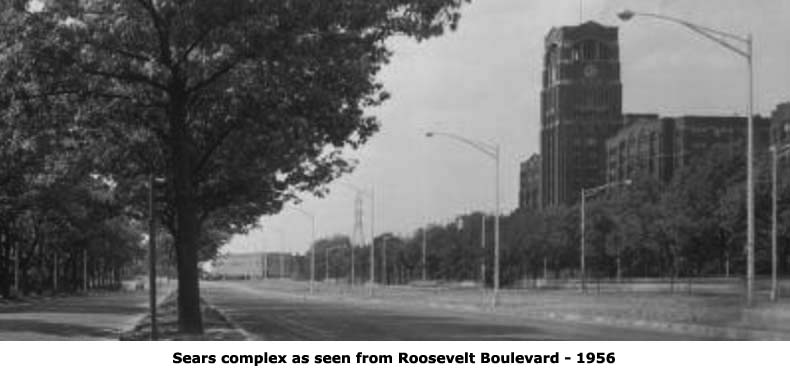
Whenever my mom shopped at the attached Sears retail store, she'd drop me off at the appliance department so I could entertain myself watching colorful red, white and blue poker chips swirl around the agitator in a demo Kenmore washing machine with see-through sides. In those pre-television days, it was great entertainment for a three year-old. Especially one with a head injury. I remember sitting quietly on the floor and watching the chips go round. If I was well-behaved, I'd be rewarded with a small bag of cashews from Sears' Nut Department. I'd eat them as we walked home from the store.
On the right side of the photo is one of those demo washers with a clear molded tub replacing the porcelain one. Whether the clear material was glass or acrylic, I don't know.
In 1941, this Kenmore washing machine was on sale for for $64.95. That's $1,180 in 2021 dollars - a lot of money. But it featured a big, insulated porcelain tub "to keep water warm. Streamlined 8-position wringer with soft balloon rolls has chromium pressure controls; push-pull safety release; roll-stop safety dry feed rest and automatic water-return board." It was available in one color only - white. My mom had a washer similar to this in 1947. By the mid-1950s, we had a matched set of an automatic washer and gas dryer.
In 1994, the giant Sears complex was demolished by implosion. It took only seven seconds for 70-plus years of history to disappear. Founded in 1886, Sears was once the largest retailer in the United States. Now it too has imploded. (posted 7/12/21, permalink)
Wanna Drag? Well known to Philadelphia and South Jersey car enthusiasts, the Atco Dragway opened in 1960. Some events have drawn thousands of spectators to this sleepy Camden County community.
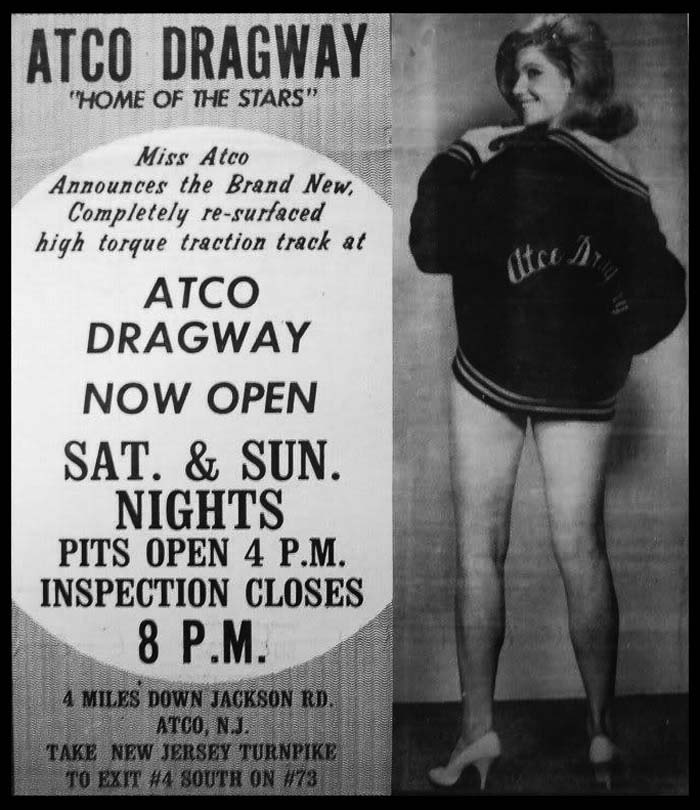
For decades, Atco drew professional racers and amateur motorheads alike, with some events drawing thousands of spectators to this sleepy Camden County community.
|
|
This front-engined dragster, owned by the Riley Brothers ran the quarter mile in 10.27 seconds with a trap speed of 137.77 mph at Atco - impressive for the early 1960s. These days top-fuel dragsters hit speeds of over 300 mph. A 2020 factory-stock Dodge Challenger Hellcat can run the quarter mile in 10.2 seconds.
|
Overly-restrictive rules enacted during the Wuhan Flu crisis may force the historic drag racing site to close. Despite the fact that the raceway is 180 open acres and has the capacity for 20-30 thousands spectators, the state capped the capacity at 30% of the grandstand. (posted 6/23/21, permalink)
Tasty T: In the 1970s and '80s, Tasty Baking used this 1915 Ford Model T delivery van in Tastykake livery to promote their snack cake products:
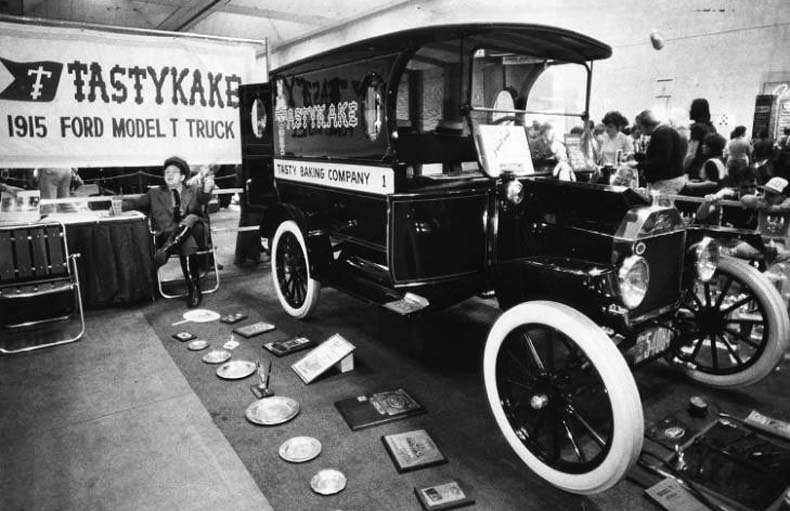
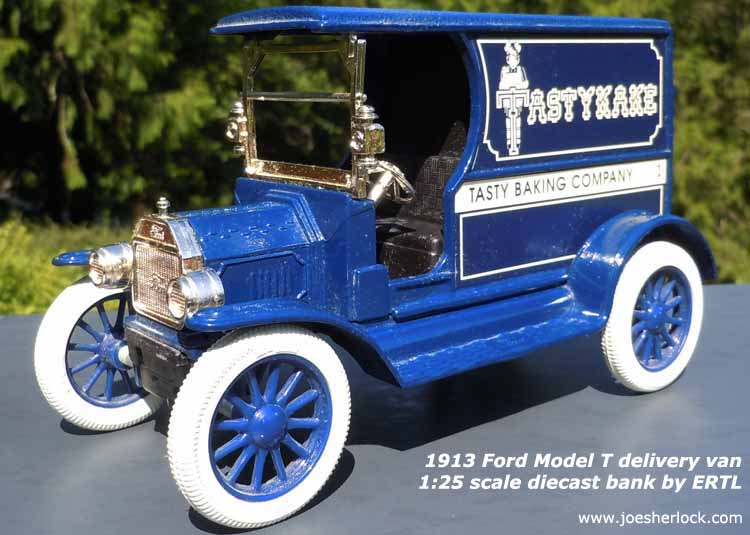
The model was offered in the early 1990s by Tasty Baking Company, Philadelphia-based makers of a legendary line of snack foods, including Tastykake cupcakes, pies, Juniors, Krimpets, Kandy Kakes and more. Tastykakes have been a Philadelphia staple since 1914. (posted 6/11/21, permalink)
When Stores Were Stylish And Elegant: We now live in an age of big box stores - dreary and bland tilt-up concrete warehouses reminiscent of buildings found in Soviet-era Russia. They are part of the Retail Apocalypse, where millions of department and specialty stores are perishing due to cheapie chains such as Wal-Mart and the rapid rise of online shopping. This inevitable decline was hastened by the 2020 pandemic.
Once upon a time, stores were elegant with entertaining window displays, designed to entice customers inside, where they could be dazzled by the decor and induced to buy something. Much attention was paid to the inside of the store as well.
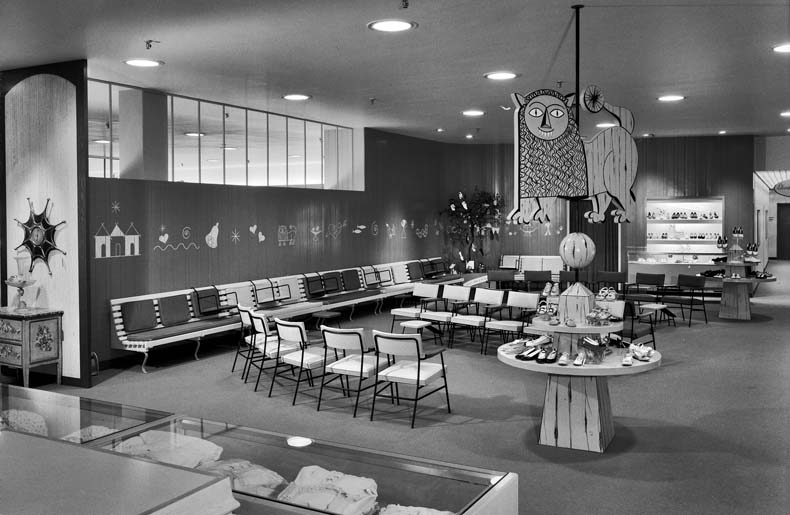
This April 16, 1955 photograph shows a very chic children's shoe department in Lord & Taylor's recently opened store in Bala Cynwyd, Pennsylvania, a suburb of Philadelphia. Lord & Taylor was an upscale department store, on par with other regional chains such as Saks Fifth Avenue, Texas' Nieman Marcus, and Seattle's Nordstrom.
Famous design firm Raymond Loewy Associates did this interior design as well much of the Bala Cynwyd's other departments. The store was one of several that Loewy designed for Lord and Taylor.

Loewy was almost a household name by the mid-1950s. His firm was responsible for the style of several cars (Raymond Loewy styled the 1932 Hupmobile, a handsome car which kept the company from going under during the depths of the Depression, the iconic three-box postwar 1947 Studebaker, the stunning, low-slung 1953 Studebaker Starliner coupe, the handsome and sleek 1962 Studebaker Avanti), Pennsylvania Railroad locomotives (T1 streamlined steam loco, GG-1 electric loco, the streamlined version of the Pennsy's K4 passenger steam locomotive), passenger coaches and other items for the PRR. In 1961, Loewy re-decorated Air Force One at the behest of Jackie Kennedy. The exterior paint scheme he recommended is still in use on the current iteration of Air Force One.
Raymond Loewy Associates also designed the Shell, Exxon, TWA and BP logos, the Greyhound Scenicruiser bus, Coca-Cola vending machines, the Lucky Strike cigarette package and Coldspot refrigerators. Loewy also helped design the Skylab space station while under contract with NASA.
Lord & Taylor was one of the world's oldest department store operators, founded as a dry goods store by two English immigrants on the Lower East Side in New York City in 1826. During the U.S. Civil War in the 1860s, it opened a special section offering mourning apparel for widows. Lord & Taylor opened its flagship store on Manhattan's Fifth Avenue in 1914, and became known for upscale fashion and its holiday window display.
In February 1955, Lord & Taylor opened a 120,000-square-foot store City Line & Belmont Avenues in Bala Cynwyd to much fanfare. The Philadelphia Inquirer reported that, on February 22nd, "an estimated 35,000 men, women and children converged … between 7 and 10 o'clock last night for a public preview of Delaware Valley's newest department store." The grand opening was spectacular with live coverage from local television networks and fashion models riding in shiny new convertibles. Traffic was jammed for miles around as people tried to get in.
It was a swell time to be in retailing. Strip mall-based discount stores such as E.J. Corvette, Two Guys, S. Klein, etc., were a minor nuisance and would not arrive in the Philadelphia area for several years. Except for Sears, mail order was an insignificant factor. Personal computers and the internet were in the far and unforeseeable future. Disposable income grew every year and retailers prospered. As people moved to the suburbs, department and specialty stores followed. Things were great … until they weren't.
In mid-2003, the New York Times reported, "Lord & Taylor, trying to recapture its aura as department store for the Junior League set, is closing 32 stores, more than one-third of its total nationally, and laying off 3,700 employees." Unfortunately, the "Junior League set" had mostly disappeared by then. Women worked. They bought clothing on the internet. Or, they saved time by mail-ordering clothes from places like Land's End. Or, they used the personal shopper service at Nordstrom. Times had changed. Lord & Taylor did not change fast enough and declared bankruptcy in 2020.
The Bala Cynwyd store closed in January 2021, officially time-stamping the end of an elegant era in retailing. (posted 6/3/21, permalink)
Hello Philadelphia! Those sleek, 1930s-era PCC streetcars were the result of a design and specification collaboration between various trolley operators and manufacturers, called the Electric Railway Presidents Conference Committee - PCC for short. The Philly trolley operator, Philadelphia Rapid Transit (PRT) did not participate.
The resulting trolley car design, dubbed the PCC offered a modern streamlined body, comfortable seating and better acceleration and braking than existing designs. It also required fewer crew members to operate. The design was available from licensed manufacturers, including St. Louis Car Company (the firm built most of the PCC cars), Pullman-Standard Corp., Clark Equipment Company (which built one aluminum-bodied PCC) and others. The first PCC cars were delivered to customers in early 1936. Philadelphia-based trolley manufacturer J. G. Brill declined to buy a license and developed their own streamlined car design, dubbed the Brilliner.
|
|
In 1938, Philadelphia Rapid Transit Co. ordered 20 of the new PCC cars, to operate on Route 53 along Wayne Avenue. All were painted a sparkly silver color. Since the line would not bring the cars downtown where people could view them, one of the cars was exhibited at the northwest entrance to City Hall. A cheerful 'Hello Philadelphia' appeared on the destination signboard on the front of the streetcar.
|
In 1938, Philadelphia Rapid Transit ordered twenty PCC cars from St. Louis Car Company; this was the first non-Brill trolley order PRT ever placed. Eventually, PRT leased three of the Brilliners. Philadelphians dubbed the modern PCC trolleys 'streamliners'.
By 1939, over 1,100 PCC cars had been produced. J. G. Brill made a strategic mistake by not becoming a PCC-licensee; relatively few Brilliners were sold. This hastened the demise of the once-mighty J. G. Brill, which ceased making trolley cars in 1940 and was merged out of existence after World War II. Atlantic City was the only city to run an all-Brilliner fleet. Atlantic City abandoned their trolley system in 1955 and the Brilliners were scrapped when no buyer could be found.
PRT became PTC - Philadelphia Transportation Company - in January, 1940. (posted 5/20/21, permalink)
Market Street 1920: This Philadelphia street scene was photographed on March 17, 1920.
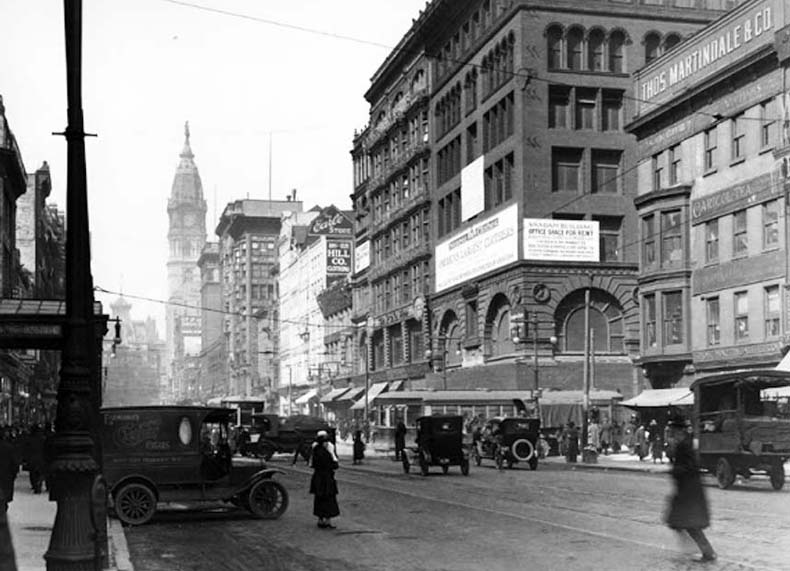
The view is looking west on Market Street near 10th St. At left is a delivery van (with oval side windows) for a cigar company. Two nearly-new Brill trolley cars are visible - one headed south, the other headed east. City Hall, topped with the statue of Billy Penn can be seen in the distance. William Penn looks cleaner than he did in 1905. Philadelphia's City Hall, topped by Penn's statue, was the tallest habitable building in the world from 1901 to 1908 and the tallest in Pennsylvania until 1932. It remained the tallest building in Philadelphia until the 1980s. During that period, Billy Penn's statue dominated the Philadelphia skyline.
In the foreground on the right is Thos. Martindale & Co. The firm dates back to 1869 and was a wholesale grocer and importer of wines, spirits and cigars. The company also sold health foods and supplements, including Alberty's Anti-Diabetic Vegetable Compound capsules, Alberty's Calcatine and Alberty's Liver Cell Salts. In 1932 and '34, Martindale & Co. was charged by the FDA with misbranding of some of their potions. (posted 5/10/21, permalink)
Clever Idea: This covered entrance to a subway trolley stop resembles an old trolley car:
It is located at the 37th St. station in Philadelphia. Subway-surface trolleys run along that line. The cream-over-green color scheme resembles those of the old Philadelphia Transit Co. (PTC).
The station is located inside University of Pennsylvania campus. There is seating in the other half of car. (posted 4/8/21, permalink)
The Decline Of Gas Stations: You've probably noticed that there are far fewer gas stations than there used to be. They were once called service stations but today most of them offer little or no service - you pump your own gas (except in Oregon and New Jersey), clean your own windshield, check your oil yourself and pump up your tires, if needed.
These days, most gas stations have a convenience store where the wash and repair bays used to be. Until the late 1970s, auto repair was a good sideline for station owners. Cars needed frequent oil changes, chassis lubrication and engine tune-ups. Fixing flat tires was a brisk and steady trade until the advent of self-sealing tubeless tires. Many service stations also sold tires (as well as radiator hoses, fan belts and batteries) and some could even arrange for an engine or transmission rebuild through an affiliated local firm. Attendants and mechanics looked official with brand-centric work uniforms and caps - some were military-style.
Today's gas stations are of a similar generic design, with distinctive bright coloring to indicate the brand of fuel sold. In the 20th Century, starting in the 1930s through the 1960s, stations used eye-catching architecture to differentiate themselves from competitors. Some were shaped like teapots or jugs (there was a jug-shaped station which still dispensed fuel in 1980s Junction City, Oregon), and later some with lighted towers constructed of glass block.
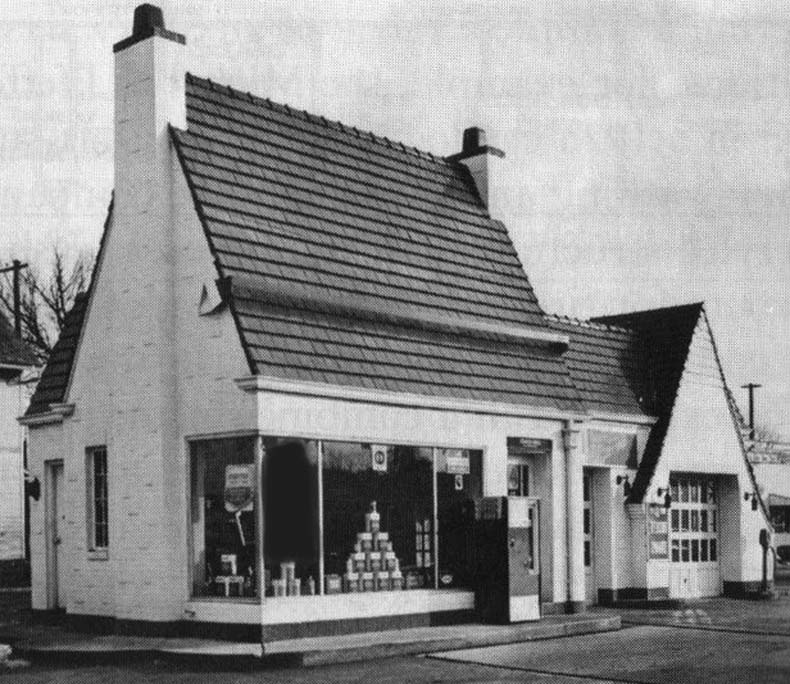 |
This Tudor revival style gas station is similar to Joe's Flying A gas, which used to be at the corner of Castor and Adams Avenues in the Frankford/Northwood Park section of Philadelphia. I worked there as a teenager, pumping gas and washing cars.
|
Called programmatic architecture, these stations assumed the fanciful shape of animals, apples, tea kettles, tepees, windmills, castles, icebergs, and airplanes. Appealing to the curiosity of passing motorists, programmatic stations were inspired by local culture, distinctive local materials, or ... (more >>>)
Remembering Larry Ferrari: People of a certain age, who grew up in the Greater Delaware Valley, will recall talented organist Larry Ferrari. The Larry Ferrari Show from 1954 to 1997 on WFIL (later WPVI) in Philadelphia, a weekly Sunday morning half-hour television program of organ music. He played Lawrence Welk-style tunes while birthday and anniversary greetings to his fans were displayed along the bottom of TV screens.
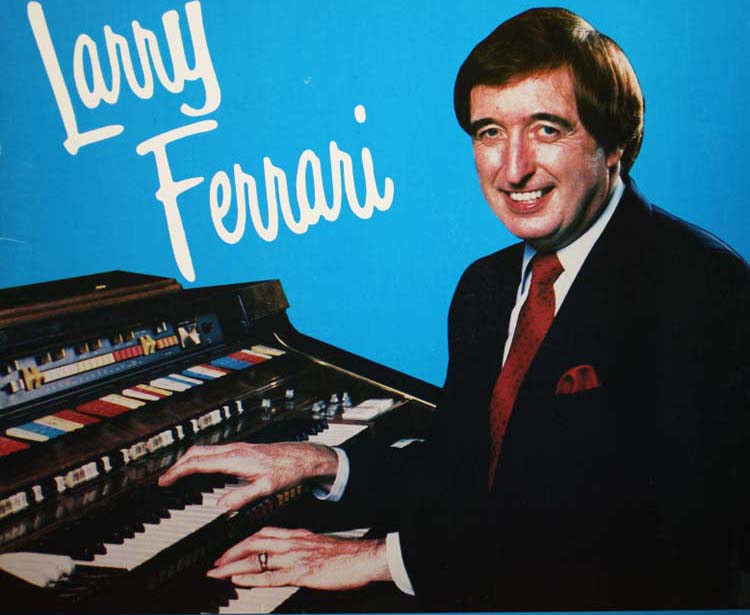
Ferrari's show lasted longer than any other show on Channel 6 with the exception of Chief Halftown. In addition to his own show, Ferrari provided the music for 'Captain Noah', 'Chief Halftown and 'Dialing For Dollars'. He was a fixture in the Channel 6 Thanksgiving Day Parade, playing the organ while riding on a float.
Ferrari never used sheet music - he could hear a piece on his car radio and later play it perfectly. He became interested in playing the organ while attending elementary school in Boston, his birthplace. At age 11, the young prodigy became organist at his church. As an adult, he was the National Concert Artist for the Lowrey Organ Company.
Because he was friends with the owner, Larry Ferrari used to play at the Roadside America tourist attraction (billed as the 'World's Greatest Miniature Village') in Pennsylvania Dutch country on weekends.
Ferrari was also known for his charitable works. He played organ at Assumption Church in Wildwood Crest, New Jersey and performed concerts for the residents in St. Mary's Catholic Home and the Manor at St. Mary's, both in Cherry Hill, NJ. From 1985 until early in 1997, Ferrari was the organist at the Cathedral of the Immaculate Conception in Camden, New Jersey and he became a close friend of Auxiliary Bishop James L. Schad.
Ferrari died on November 30, 1997 after a battle with leukemia. He was 65 and a resident of Cinnaminson, New Jersey. Bishop Schad celebrated Ferrari's funeral Mass at the Cathedral of the Immaculate Conception. As part of the service, Carter Merbreier (Captain Noah) shared his memories of Ferrari. Larry is buried in West Laurel Hill Cemetery in Bala Cynwyd, PA. next to his mother, Columba, who died in 1989.
In 2000, Larry Ferrari was inducted into the Hall of Fame of the Broadcast Pioneers of Philadelphia. (posted 3/1/21, permalink)
Philly Nuts: Near the Ben Franklin Bridge, just before the Frankford Elevated descended underground, there was the Lummis Peanuts plant, at 139 Water St. just north of the Ben Franklin Bridge. The building is now demolished - it once proudly carried the Lummis name on the water tower.
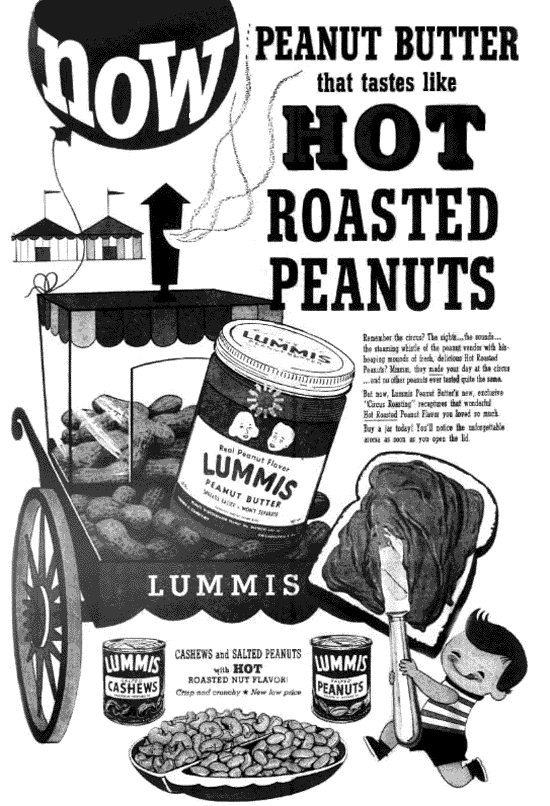
June 1956 print ad from Philadelphia Inquirer
Sometimes, on the 'old' pre-1960 El cars - which had windows that opened, you could smell the peanuts roasting.
In July 1960, the New York Times noted that the United States Tobacco Company expanded "its nut business on a national scale through the acquisition of Lummis Co., Philadelphia manufacturer of canned nuts and packaged nut products and large wholesaler of raw peanuts." (posted 1/25/21, permalink)